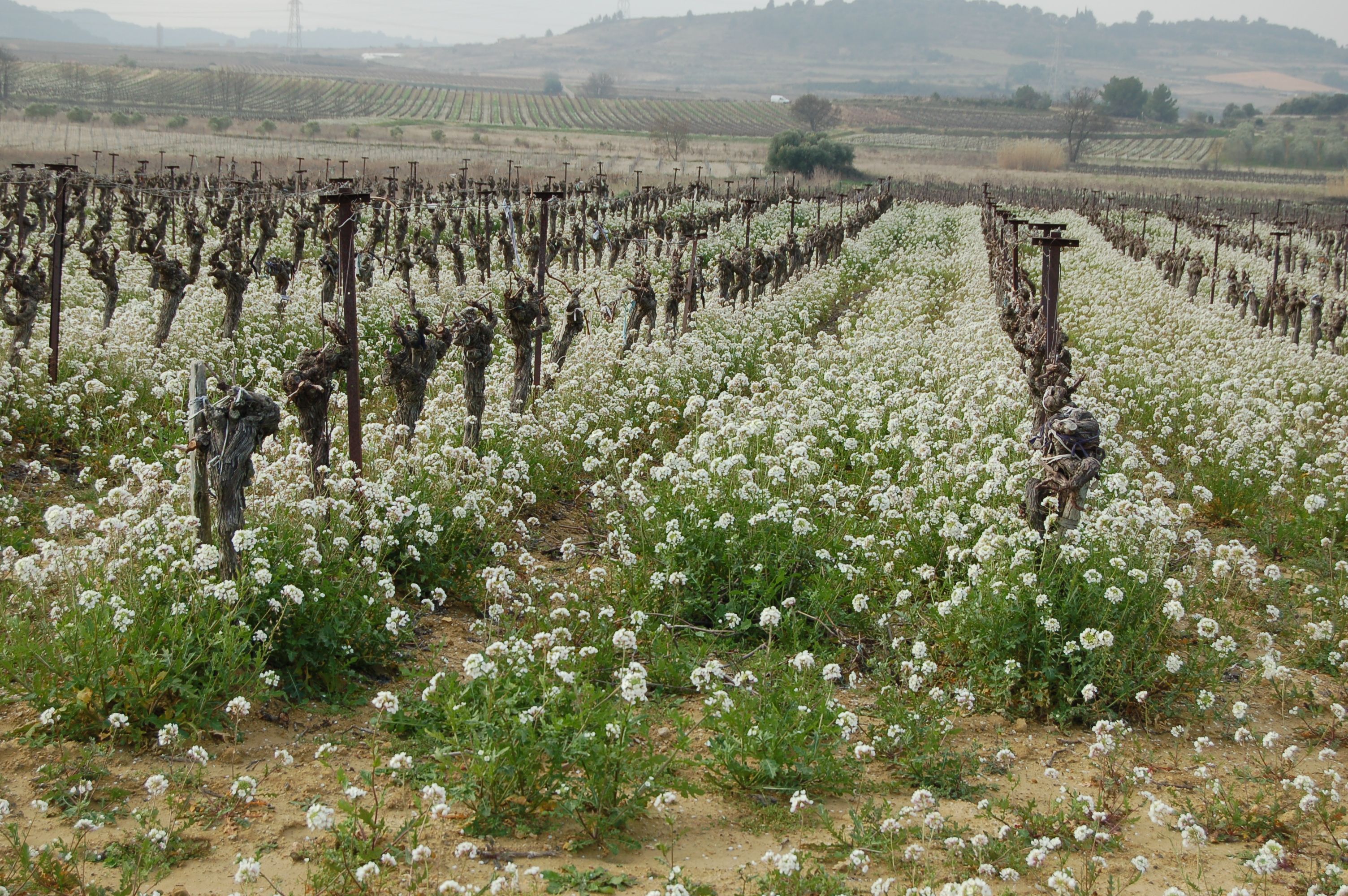Plant cover in viticulture
 Which plant cover to choose, integrating mulch, geochanvre, etc.
Which plant cover to choose, integrating mulch, geochanvre, etc.

In viticulture, the use of plant cover has different interests and functions depending on whether it is planted in the inter-row or on the cavaillon. This page sets out the main principles and issues involved in this set of practices, with links to more detailed articles on some of the techniques covered.
Row covers and mulches
The main aim of row covers and mulches is to control the development of weeds without resorting to chemical weeding. However, their installation also offers benefits for the soil structure : they limit run-off, reduce surface evaporation and reduce the risk of compaction caused by tool use.[1].
Plant cover
The maintenance of plant cover on the cavaillon, whether sown or volunteer, is also known as"total grassing".
Maintaining spontaneous grass cover is considered to be the easiest alternative to implement, but it can take longer to control and competition with the vines can be more difficult to manage.[2]
It is important to note that managing a cover crop under the row generally requires special equipment, such as inter-row mowers.
- Feedback on the implementation of total grass cover in Alsace.
- Feedback on a practice of sowing total grass cover using a fat plant(Sédum sp.) in Ardèche.
Choice of species
In the case of a cover crop sown under the row, species with the following characteristics are generally chosen.[3][4]:
- Low competition for water or nitrogen, depending on the region, so as not to harm the development of the vines.
- Low shoot height, to maintain good aeration of the bunches and keep maintenance to a minimum.
- Fast establishment and high covering power to "smother" weeds over the long term.
Here are a few examples of species that meet these criteria and have been used in experiments :
Grass red fescue(Festuca rubra), roof brome(Bromus tectorum), rat barley(Hordeum murinum), pilosella hawkweed(Pilosella officinarum) [5]. Or sheep fescue(Festuca ovina), koeleria(Koeleria macrantha), orchard grass(Dactylis glomerata), meadow grass(Poa pratensis), birdsfoot trefoil(Lotus corniculatus) and certain varieties of clover.[2].
Sowing
Sowing generally takes place in autumn, and requires tools to be used on the surface to prepare a seedbed. The lack of dedicated seed drills on the market is a significant obstacle. In its "Guide pratique de l'enherbement sous le rang", IFV recommends broadcast sowing using a localised fertiliser spreader.[2].
Mulching
Similar to what can be done in arboriculture,mulches can beapplied under the row. They are an alternative to mechanical weeding andgrassing to reduce the use of herbicides, but can also be considered as a contribution of organic matter.
- Here's a look back at a wool-based mulching experiment in the Ardèche.
Different types of mulch
There are two types of mulch :
- organic mulch,
- biodegradable fabric mulch.
The straw used often comes from poaceae(wheat or sometimes miscanthus) or hemp (chenevotte), and for certain plots that are difficult to access and maintain, wool-based mulches are sometimes used.
Some experiments have also highlighted the value of these mulches as an alternative to mechanical weeding on young vines.[6]particularly those based on wood chips or hardwood bark(Bois Raméal Fragmenté)[7].
Inter-row plant cover
As far asis concerned, inter-row cover crops are generally used asgreen manures. The aim is to sow a cover crop that develops inautumn, when the vine's nitrogen requirements are low, and then to destroy it and return it in the form of organic matter in spring, when the vine absorbs morenitrogen.[8]. This enables the nitrogen that is not mobilised during the autumn mineralisation peak to be captured, thus preventing it from being washed away.
Feedback on the implementation and monitoring of inter-row green manure :
- Alain LACROIX (17), in collaboration with the Charente-Maritime Chamber of Agriculture.
- François DARGELOS (32), filmed during a winegrowing technical day by Ver de terre Production.
- Marie Florence, Antoine and Jean Etienne PIGNIER (39), for planting semi-direct green manures.
Depending on its composition, a canopy can provide various other eco-systemic benefits and services, such as.[9]:
- Biodiversity support for beneficials and pollinators, soil microfauna, and a winter food source for game.
- Capture and storage of atmospheric carbon in the soil.
- Controls weeds.
- Soil structuring and stabilisation via the root systems of introduced species.
The technical sheets on planting cover crops and destroying green manures in vineyards provide a detailed list of all the information you need to know about inter-row cover crops.
References
- ↑ Göblyös et al. (2011) Comparison of three soil management methods in the Tokaj wine region, Mitteilungen Klosterneuburg: 187-195
- ↑ 2.0 2.1 2.2 IFV sud-ouest, Mini-guide pratique de l'enherbement sous le rang en viticulture, 2019. https://www.vignevin-occitanie.com/wp-content/uploads/2019/09/Mini-guide-Enherbement.pdf
- ↑ Association technique viticole du Maine-et-Loire, Les plantes couvres sols à l'essai, Biofil n°110 Mars/Avril 2017. https://abiodoc.docressources.fr/doc_num.php?explnum_id=2914
- ↑ Indre-et-Loire Chamber of Agriculture, "Cover crops and straw in vines for weed control" video, 2021. https://www.youtube.com/watch?v=o6X-6tasDHQ
- ↑ Delpuech, IFV Pôle méditerrannée, Grass cover under the row: a new alternative to chemical weeding of the vine stock line? 2014. https://www.vignevin.com/wp-content/uploads/2019/03/AE41_EnherbementRang.pdf
- ↑ GONTIER, GAVIGLIO. Implementation of under-row mulches as a weed control solution in viticulture. IFV Pôle Sud-Ouest 2014. https://www.vignevin-occitanie.com/wp-content/uploads/2018/10/3-paillage-sous-rang.pdf
- ↑ Muller et al. Towards more input-efficient viticulture ? Some agronomic results from the DEPHY scheme in Alsace. LES Lettres AB Mag Bio en grand Est - #13 - Dec. 2018. https://hal.inrae.fr/hal-02622702
- ↑ FIBL presentation on "temporary plant cover in viticulture", 2020.https://www.youtube.com/watch?v=wR_OOFGbDcc
- ↑ Charente martitime Chamber of Agriculture, video "Tout savoir sur les engrais verts en viticulture", 2018https://www.youtube.com/watch?v=jpaM0FbuzH4